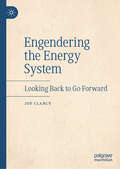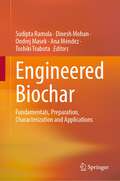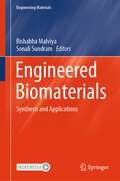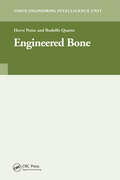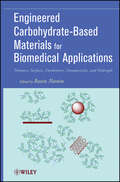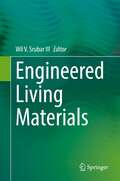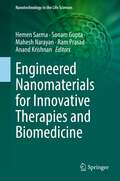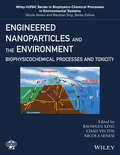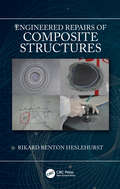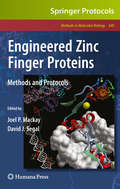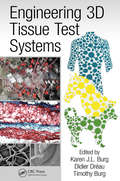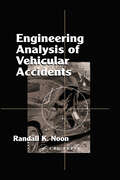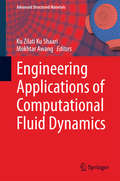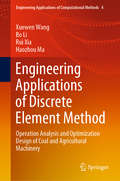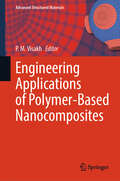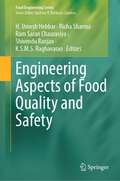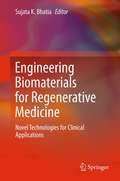- Table View
- List View
Engendering the Energy System: Looking Back to Go Forward
by Joy ClancyThis book brings together a comprehensive overview of gender and energy to provide an invaluable resource for researchers and practitioners. It addresses how energy access at the individual/household/community level is gendered in terms of decision making and where and how benefits accrue. At the institutional level it examines the role women play in the sector and the barriers they have to overcome to participate. At the policy level experiences with mainstreaming gender into energy policy are discussed. The book provides examples from both the Global South and the Global North and is set in the context of the energy transition. The book is a timely publication that highlights the global energy initiatives of SEforAll, the SDGs and the Paris Agreement on Climate Change.
Engine Exhaust Particulates (Energy, Environment, and Sustainability)
by Avinash Kumar Agarwal Atul Dhar Nikhil Sharma Pravesh Chandra ShuklaThis book provides a comparative analysis of both diesel and gasoline engine particulates, and also of the emissions resulting from the use of alternative fuels. Written by respected experts, it offers comprehensive insights into motor vehicle particulates, their formation, composition, location, measurement, characterisation and toxicology. It also addresses exhaust-gas treatment and legal, measurement-related and technological advancements concerning emissions. The book will serve as a valuable resource for academic researchers and professional automotive engineers alike.
Engine Oils and Automotive Lubrication (Mechanical Engineering Ser. #80)
by Wilfried J. BartzDiscusses all the major aspects of automotive and engine lubrication - presenting state-of-the-art advances in the field from both research and industrial perspectives. This book should be of interest to mechanical, lubrication and automotive engineers, automotive and machinery designers as well as undergraduate and graduate students in these fields.
Engineer In The Garden
by Colin TudgeToday we are developing a science that could change the world - for good or ill - more quickly and more profoundly than ever before. The science of genetics promises - or threatens - nothing less than the creation of life. Colin Tudge leads the reader gently through the deepest intricacies of genetics. He traces its history. He explores its awesome power and its current applications. And he speculates on its thrilling - or terrifying - future. He has written an essential book for anyone interested in the future of the human race.
Engineered Antimicrobial Surfaces (Materials Horizons: From Nature to Nanomaterials)
by Sabu Thomas Nandakumar Kalarikkal S. Snigdha E. K. RadhakrishnanThis volume looks at the different aspects involved in controlling microbial growth and the techniques employed in obtaining sterile surfaces. It covers research on coatings, nano-materials, herbal materials, naturally occurring antimicrobials in designing antimicrobial surfaces. It discusses issues of antibiotic resistance, synthesis techniques, toxicity, and current and potential applications of antimicrobial surfaces, and this book will serve as a useful reference to a broad range of scientists, industrial practitioners, graduate and undergraduate students, and other professionals in the fields of polymer science and engineering, materials science, surface science, bioengineering and chemical engineering.
Engineered Biochar: Fundamentals, Preparation, Characterization and Applications
by Dinesh Mohan Sudipta Ramola Ondrej Masek Ana Méndez Toshiki TsubotaThis book systematically covers the fundamentals and applications of modified biochar. The 19 chapters are divided into 3 sections that provide a holistic overview for researchers from all related fields. Section 1 and 2 present the pyrolysis process, including the advantages and limitations of the physical, chemical, and biological modification methods and characterization of modified biochar. Section 3 highlights the wide spectrum of applications of modified biochar in fuel cells and batteries, remediation of organic and inorganic contaminants from soil and water and soil fertilization. Given its scope, the book appeals to a broad readership in various fields of chemical engineering, materials science, and environmental science.
Engineered Biomaterials: Synthesis and Applications (Engineering Materials)
by Rishabha Malviya Sonali SundramThis book highlights recent advances focusing on the synthesis methods of engineered biomaterials and their applications. The book discusses recent applications of various approaches and technology in improving the functional properties and biological activities of biopolymers. It includes two major sections: the first section introduces a range of methods which lead to materials with enhanced properties for a range of practical applications, along with the positives and limitations of the techniques. The second section covers recent trends and advances in application of engineered biomaterials that assist materials scientists and researchers in mapping out the future of these new improved materials through value addition in order to enhance their use. Contributions in the book are done by prominent researchers from industry, academia, and government/private research laboratories across the globe. The book summarizes in a fairly comprehensive manner many of the recent technical advancements in the area of biopolymers. The book is intended to serve as a reference resource in the area of polymers science.
Engineered Bone
by Herve PetiteThis book addresses relevant issues that tissue-engineering researchers must consider when planning new strategies, especially in the bone and cartilage field. It describes transcription factors that are essential in bone development, and deals with bone healing.
Engineered Carbohydrate-Based Materials for Biomedical Applications
by Ravin NarainThis book addresses the need for a comprehensive book on the design, synthesis, and characterization of synthetic carbohydrate-based polymeric materials along with their biological applications. The first two chapters cover the synthesis and self-assembly of glycopolymers and different techniques for creating these synthetic polymers. Subsequent chapters account for the preparation of block copolymers, branched glycopolymers, glycosurfaces, glycodendrimers, cationic glycopolymers, bioconjugates, glyconanoparticles and hydrogels. While these chapters comprehensively review the synthetic and characterization methods of those carbohydrate-based materials, their biological applications are discussed in detail.
Engineered Living Materials
by Wil V. SrubarThis book will serve as a primer for readers to understand recent advances, applications, and current challenges in the field of Engineered Living Materials. The chapters cover core science and engineering research areas, including (1) advances in synthetic biology and genetic programmability for Engineered Living Materials, (2) functional Engineered Living Material for application in energy, electronics, and construction, and (3) novel manufacturing approaches for Engineered Living Materials at multiple scales. The emerging field of Engineered Living Materials represents a significant paradigm shift in materials design and synthesis, in which living cells are used to impart biologically active functionalities to manmade materials. The result is a genetically programmable augmentation of non-living matter to exhibit unprecedented life-like (i.e., living) capabilities. At the intersection of synthetic biology and materials science, the field of Engineered Living Materials exhibits unprecedented promise and potential to alter the way we synthesize new materials and design medical devices, fabrics, robotics, commodity polymers, and construction materials. Materials with attributes of living systems can be engineered with an ability to respond to their environment and designed to self-repair in response to physical or other stresses or detect the presence of specific stimuli, such as light, heat, pressure, or hazardous chemical compounds. Although nascent, scientists and researchers in the field of Engineered Living Materials have made marked advances in demonstrating a potential to revolutionize a multitude of science and engineering disciplines. This volume will define the current state of the art of Engineered Living Materials, and highlight grand opportunities and challenges that abound at the nexus of synthetic biology and materials science and engineering.
Engineered Nanomaterials for Innovative Therapies and Biomedicine (Nanotechnology in the Life Sciences)
by Ram Prasad Mahesh Narayan Anand Krishnan Hemen Sarma Sonam GuptaResearch on biomedical applications of nanomaterials has exhibited the rapidly evolving field of biomedical sciences by showing how effective they are in treatment. These particles hold considerable potential for biomedical applications. Work is ongoing, and the results suggest a possibility for a sustainable future for nanomaterials in both therapeutic and biomedical fields. This book highlights current and emerging applications, taking global research findings into consideration. We believe the focus on the identification and role of nanomaterial applications in therapeutic and biomedical sciences can lead to novel solutions in the fields. The chapters of this book are disseminated in a manner that can be readily adopted as sources for new and further study. The editors integrate advanced texts in their research that help graduate students, researchers and professors. Additionally, we believe that international readers will be able to make use of this book for reference purposes.
Engineered Nanoparticles and the Environment: Biophysicochemical Processes and Toxicity
by Baoshan Xing Nicola Senesi Chad D. VecitisDetails the source, release, exposure, adsorption, aggregation, bioavailability, transport, transformation, and modeling of engineered nanoparticles found in many common products and applications Covers synthesis, environmental application, detection, and characterization of engineered nanoparticles Details the toxicity and risk assessment of engineered nanoparticles Includes topics on the transport, transformation, and modeling of engineered nanoparticles Presents the latest developments and knowledge of engineered nanoparticles Written by world leading experts from prestigious universities and companies
Engineered Repairs of Composite Structures
by Rikard Benton HeslehurstEngineered Repairs of Composite Structures provides a detailed discussion, analysis, and procedures for effective and efficient repair design of advanced composite structures. It discusses the identification of damage types and the effect on structural integrity in composite structures, leading to the design of a repair scheme that focusses on the restoration of the structural integrity and damage tolerance. This book teaches the reader to better understand effective and efficient repair design, allowing for more structurally effective repairs of damaged composite structures. It also discusses the application of the repair and what is needed in the forming of the composite repair to meet the engineering design requirements. Aimed at materials engineers, mechanical engineers, aerospace engineers, and civil engineers, this practical work is a must have for any industry professional working with composite structures.
Engineered Zinc Finger Proteins
by Joel P. Mackay David J. SegalAmong the many types of DNA binding domains, C2H2 zinc finger proteins (ZFPs) have proven to be the most malleable for creating custom DNA-binding proteins. In Engineered Zinc Finger Proteins: Methods and Protocols, expert researchers from some of the most active laboratories in this field present detailed methods, guidance, and perspectives. The volume contains sections covering the engineering of ZFPs, methods for the creation, evaluation, and delivery of artificial transcription factors (ATFs), methods for the creation and evaluation of zinc finger nucleases (ZFNs), and a collection of the several applications and assays beyond ATFs and ZFNs, including zinc finger transposases and ChIP-seq methodology amongst other subjects. Written in the highly successful Methods in Molecular BiologyTM series format, chapters include introductions to their respective topics, lists of the necessary materials and reagents, step-by-step, readily reproducible laboratory protocols, and notes on troubleshooting and avoiding known pitfalls. Comprehensive and cutting-edge, Engineered Zinc Finger Proteins: Methods and Protocols aims to aid both seasoned practitioners and new investigators with its vital methods and insights as they seek to create the next generation of engineered ZFPs and applications.
Engineering 3D Tissue Test Systems
by Karen J. L. Burg, Didier Dréau and Timothy BurgEngineering 3D Tissue Test Systems provides an introduction to, and unique coverage of, a rapidly evolving area in biomaterials engineering. It reveals the current and future research responses, the current and future diagnostic applications, and provides a comprehensive overview to foster innovation. It offers insight into the importance of 3D systems and their use as benchtop models, spanning applications from basic scientific research to clinical diagnostics. Methods and limitations of building 3D tissue structures are evaluated, with attention given to the cellular, polymeric, and fabrication instrumentation components. The book covers the important aspects of polymeric tissue test systems, highlighting the needs and constraints of the industry, and includes a chapter on regulatory and pricing issues.
Engineering Acoustics: Noise and Vibration Control (Wiley Series in Acoustics Noise and Vibration)
by Malcolm J. Crocker Jorge P. ArenasA comprehensive evaluation of the basic theory for acoustics, noise and vibration control together with fundamentals of how this theoretical material can be applied to real world problems in the control of noise and vibration in aircraft, appliances, buildings, industry, and vehicles. The basic theory is presented in elementary form and only of sufficient complication necessary to solve real practical problems. Unnecessary advanced theoretical approaches are not included. In addition to the fundamental material discussed, chapters are included on human hearing and response to noise and vibration, acoustics and vibration transducers, instrumentation, noise and vibration measurements, and practical discussions concerning: community noise and vibration, interior and exterior noise of aircraft, road and rail vehicles, machinery noise and vibration sources, noise and vibration in rapid transit rail vehicles, automobiles, trucks, off road vehicles, and ships. In addition, extensive up to date useful references are included at the end of each chapter for further reading. The book concludes with a glossary on acoustics, noise and vibration
Engineering Analysis of Fires and Explosions
by Randall K. NoonEngineering Analysis of Fires and Explosions demonstrates how professional forensic engineers apply basic concepts and principles from engineering and scientific disciplines to analyze fires and explosions. It describes how forensic engineers use a "reverse design" process to determine the original cause of a fire or explosion. This guide incorporates practices and lessons learned from the first-hand experiences of the author and his colleagues. It is an exciting introduction to the multidisciplinary subject of fire and explosion analysis and its legal ramifications. The author's straightforward language and style make the concepts easy to understand.
Engineering Analysis of Vehicular Accidents
by Randall K. NoonAccident analysis is not like a classroom problem where the equations are selected and solved, and the matter is considered closed. In this line of forensics, engineering skill must be combined with skillful practice for the successful presentation of evidence to a jury. In this book, the author demonstrates the application of engineering skills, methods, and judgment for analyzing vehicular accidents. A definition of vehicular accident reconstruction and its role in the legal system is provided. General accident statistics are cited, and some general strategies for accident reconstruction are given, along with many examples and case studies. The author includes novel and unusual treatment of the momentum method and coefficient of restitution (which is not yet widespread in accident analysis) and shows how to select the best methods of analysis in a given accident reconstruction.
Engineering Applications of Polymer based Nano Blends (Advanced Structured Materials #235)
by P. M. VisakhThis book presents engineering applications of polymer-based nano-blends. It discusses the recent developments, in the area of engineering applications, and summarizes many of the important polymer-based nano-blends. In particular, it looks into more advanced topics like blends in biomedical applications, biorecognition of anticancer drug daunorubicin application, binders for particle board, packaging applications, thermoplastic starch-based LLDPE films for active packaging, and optical and antibacterial applications.
Engineering Applications of Computational Fluid Dynamics
by Ku Zilati Ku Shaari Mokhtar AwangThis volume presents the results of Computational Fluid Dynamics (CFD) analysis that can be used for conceptual studies of product design, detail product development, process troubleshooting. It demonstrates the benefit of CFD modeling as a cost saving, timely, safe and easy to scale-up methodology.
Engineering Applications of Discrete Element Method: Operation Analysis and Optimization Design of Coal and Agricultural Machinery (Engineering Applications of Computational Methods #4)
by Bo Li Xuewen Wang Rui Xia Haozhou MaThis book introduces the engineering application of the discrete element method (DEM), especially the simulation analysis of the typical equipment (scraper conveyor, coal silos, subsoiler) in the coal and agricultural machinery. In this book, the DEM is applied to build rigid and loose coupling model, and the kinematic effect of the bulk materials, the mechanical effect of the interaction between the bulk materials, and the mechanical equipment in the operation process of the relevant equipment are studied. On this basis, the optimization design strategy of the relevant structure is proposed. This book effectively promotes the application of DEM in engineering, analyzes the operation state, failure mechanism, and operation effect of related equipment in operation, and provides theoretical basis for the optimal design of equipment. The book is intended for undergraduate and graduate students who are interested in mechanical engineering, researchers investigating coal and agricultural machinery, and engineers working on designing related equipments.
Engineering Applications of Polymer-Based Nanocomposites (Advanced Structured Materials #237)
by P. M. VisakhThis book presents engineering applications of polymer-based nanocomposites. It discusses the recent developments, in the area of engineering applications, and summarizes many of the important polymer-based nanocomposites. In particular, it looks into more advanced topics like nanocomposites for renewable energy storage system, solar cells, antimicrobial and -bacterial applications, biosensing, smart packaging, food packaging, tissue engineering applications. Therefore, the book covers an up-to-date record on the major findings and observations in the field of engineering applications of polymer-based nanocomposites. It serves as a &“one stop&” reference resource for important research accomplishments in the above area.
Engineering Aspects of Food Quality and Safety (Food Engineering Series)
by Shivendu Ranjan H. Umesh Hebbar Richa Sharma Ram Saran Chaurasiya K. S. M. S. RaghavaraoEngineering Aspects of Food Quality and Safety aims to fill the knowledge gap in current technological advances and methods for food safety and quality, dedicating entire sections to analytical techniques from quality testing to packaging, post-harvest methods from product utilization to storage to chemical engineering principles and pre-harvest interventions from genetic engineering and mechanization to the links between pre-and-post harvest techniques. Throughout the book, global policy perspectives are taken into account. An introductory section is also included to cover the role of food processing and engineering in food quality and safety improvement. Encompassing all of the major applications and challenges involved in the engineering aspects of food safety and quality in one source, this work is incredibly valuable to a wide range of food engineers, scientists, and industry professionals involved in the engineering, processing and packaging of both novel and traditional foods. This text provides a detailed overview of the newest methods and advanced technologies used in the improvement of quality and safety in foods. The processes and methods described in this book are applicable to many areas of the food industry including pre-harvest and post-harvest technology, food machinery and product formulation. Featuring contributions from prominent food scientists and engineers across the globe, this work contains detailed coverage of the latest advances in genetic and chemical engineering, mechanization, thermal and non-thermal processing, automation, computational tools, packaging and waste management. The latest analytical techniques are also covered, including chapters dedicated to in-line monitoring, nanosensors, rapid testing kits and E-sensors. Maintaining a high standard of safety for consumers in foods is an interdisciplinary effort involving biologists, chemists, nutritionists, chemical engineers, mechanical engineers and genetic engineers among others. All of these experts will find this book to be a singular source encompassing all of the major current advances in food safety engineering and processing.
Engineering Biomaterials for Neural Applications
by Elizabeth NanceThis contributed volume explores the ways in which researchers engineer new biomaterials for the challenging problems of the peripheral and central nervous systems. These biomaterials are uniquely positioned for use in creating in vitro models of injury and disease, testing therapeutic treatments, understanding neural development, and mapping the multi-scalar environment of the brain. This book informs readers from biology, chemistry, materials science, engineering, and neuroscience on cutting edge research in engineering technologies, from fundamental material development through pre-clinical studies. The book also highlights target applications in three areas of research: (1) engineering neural models and materials, (2) probing biological underpinnings of neurological function and disease, and (3) designing therapeutic and diagnostic treatments for neurological disease.
Engineering Biomaterials for Regenerative Medicine
by Sujata K. BhatiaRegeneration of tissues and organs remains one of the great challenges of clinical medicine, and physicians are constantly seeking better methods for tissue repair and replacement. Tissue engineering and regenerative medicine have been investigated for virtually every organ system in the human body, and progress is made possible by advances in materials science, polymer chemistry, and molecular biology. This book reviews the current status of biomaterials for regenerative medicine, and highlights advances in both basic science and clinical practice. The latest methods for regulating the biological and chemical composition of biomaterials are described, together with techniques for modulating mechanical properties of engineered constructs. Contributors delineate methods for guiding the host response to implantable materials, and explain the use of biologically-inspired materials for optimal biological functionality and compatibility. The book culminates in a discussion of the clinical applications of regenerative medicine. By integrating engineering and clinical medicine, Engineering Biomaterials for Regenerative Medicine examines how tissue engineering and regenerative medicine can be translated into successful therapies to bridge the gap between laboratory and clinic. The book will aid materials scientists and engineers in identifying research priorities to fulfill clinical needs, and will also enable physicians to understand novel biomaterials that are emerging in the clinic. This integrated approach also gives engineering students a sense of the excitement and relevance of materials science in the development of novel therapeutic strategies.
